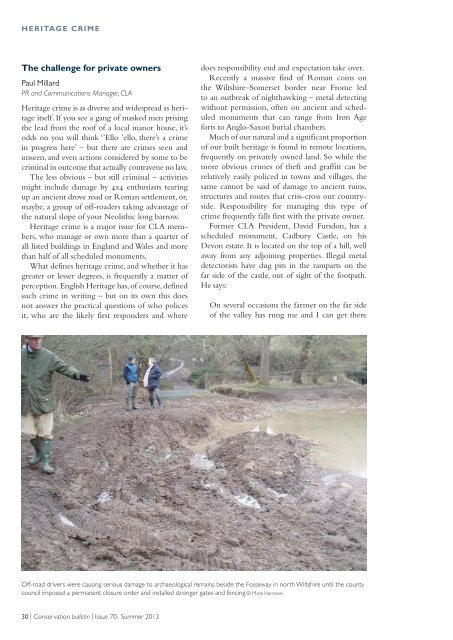Conservation Bulletin 70 | PDF - English Heritage
Conservation Bulletin 70 | PDF - English Heritage
Conservation Bulletin 70 | PDF - English Heritage
You also want an ePaper? Increase the reach of your titles
YUMPU automatically turns print PDFs into web optimized ePapers that Google loves.
HERITAGE CRIME<br />
The challenge for private owners<br />
Paul Millard<br />
PR and Communications Manager, CLA<br />
<strong>Heritage</strong> crime is as diverse and widespread as heritage<br />
itself. If you see a gang of masked men prising<br />
the lead from the roof of a local manor house, it’s<br />
odds on you will think ‘’Ello ’ello, there’s a crime<br />
in progress here’ – but there are crimes seen and<br />
unseen, and even actions considered by some to be<br />
criminal in outcome that actually contravene no law.<br />
The less obvious – but still criminal – activities<br />
might include damage by 4x4 enthusiasts tearing<br />
up an ancient drove road or Roman settlement, or,<br />
maybe, a group of off-roaders taking advantage of<br />
the natural slope of your Neolithic long barrow.<br />
<strong>Heritage</strong> crime is a major issue for CLA members,<br />
who manage or own more than a quarter of<br />
all listed buildings in England and Wales and more<br />
than half of all scheduled monuments.<br />
What defines heritage crime, and whether it has<br />
greater or lesser degrees, is frequently a matter of<br />
perception. <strong>English</strong> <strong>Heritage</strong> has, of course, defined<br />
such crime in writing – but on its own this does<br />
not answer the practical questions of who polices<br />
it, who are the likely first responders and where<br />
does responsibility end and expectation take over.<br />
Recently a massive find of Roman coins on<br />
the Wiltshire–Somerset border near Frome led<br />
to an outbreak of nighthawking – metal detecting<br />
without permission, often on ancient and scheduled<br />
monuments that can range from Iron Age<br />
forts to Anglo-Saxon burial chambers.<br />
Much of our natural and a significant proportion<br />
of our built heritage is found in remote locations,<br />
frequently on privately owned land. So while the<br />
more obvious crimes of theft and graffiti can be<br />
relatively easily policed in towns and villages, the<br />
same cannot be said of damage to ancient ruins,<br />
structures and routes that criss-cross our countryside.<br />
Responsibility for managing this type of<br />
crime frequently falls first with the private owner.<br />
Former CLA President, David Fursdon, has a<br />
scheduled monument, Cadbury Castle, on his<br />
Devon estate. It is located on the top of a hill, well<br />
away from any adjoining properties. Illegal metal<br />
detectorists have dug pits in the ramparts on the<br />
far side of the castle, out of sight of the footpath.<br />
He says:<br />
On several occasions the farmer on the far side<br />
of the valley has rung me and I can get there<br />
Off-road drivers were causing serious damage to archaeological remains beside the Fosseway in north Wiltshire until the county<br />
council imposed a permanent closure order and installed stronger gates and fencing.© Mark Harrison<br />
30 | <strong>Conservation</strong> bulletin | Issue <strong>70</strong>: Summer 2013

















